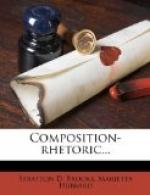Notice how the relation in time of each paragraph to the preceding is shown by the following sentences of parts of sentences taken in order from a magazine article entitled “Yachting at Kiel,” by James B. Connolly:—
1. It was slow waiting in Travemunde. The
long-enduring twilight of a
summer’s
day at fifty-four north began to settle down...
2. The dusk comes on, and on the ships of war
they seem to be getting
nervous...
3. The dusk deepens...
4. It is getting chilly in the night air, with
the rations running low,
and the charterers
of some of the fishing boats decide to go home...
5. It is eleven o’clock—dark
night—and the breeze is freshening, when
the first of the
fleet heaves in sight...
6. After that they arrive rapidly...
7. At midnight there is still no Meteor...
8. Through the entire night they keep coming...
9. Next morning...
+Theme XLVI.+—Write a narrative, four or more paragraphs in length, showing the time-order.
Suggested subjects:—
1. The race up the river.
2. The life of some well-known
man.
3. The cake that fell.
4. Retell some incident
that you have recently read.
5. Relate some personal
experience.
6. A story suggested
by the picture on page 160.
(Make an outline. Consider the unity, coherence, and emphasis of each paragraph separately. Then consider the unity, coherence, and emphasis of the whole composition. Notice what expressions you have used to indicate the relations in time. Have you used the same expression too often?)
+86. Development of a Composition with Reference to Position in Space.+— A second method of development is to relate details with reference to their position in space.
[Illustration]
Just as we may give either a paragraph or a whole theme coherence by following a given time-order, so may we make a paragraph or a whole theme coherent by arranging the parts in an order determined by their position in space. In developing a theme by this method we simply apply to the whole theme the principles discussed for the development of a paragraph (Section 47).
In a description composed of several paragraphs, each paragraph should contain a group of details closely related to one another in space. The paragraphs should be constructed so that each shall possess unity and coherence within itself, and they should be so arranged that we may pass most easily from the group of images presented by one paragraph to the images presented by the next. In narration, the space arrangement may supplement time-order in giving coherence.
If the most attractive features of an art room are its wall decorations, five paragraphs describing the room may be as follows:—
1. Point of view: general impression. 2. The north wall: general impression; details. 3. The east wall: general impression; details. 4. The south wall: general impression; details. 5. The west wall: general impression; details.
It is easy to imagine a room in the description of which the following paragraphs would be appropriate:—




